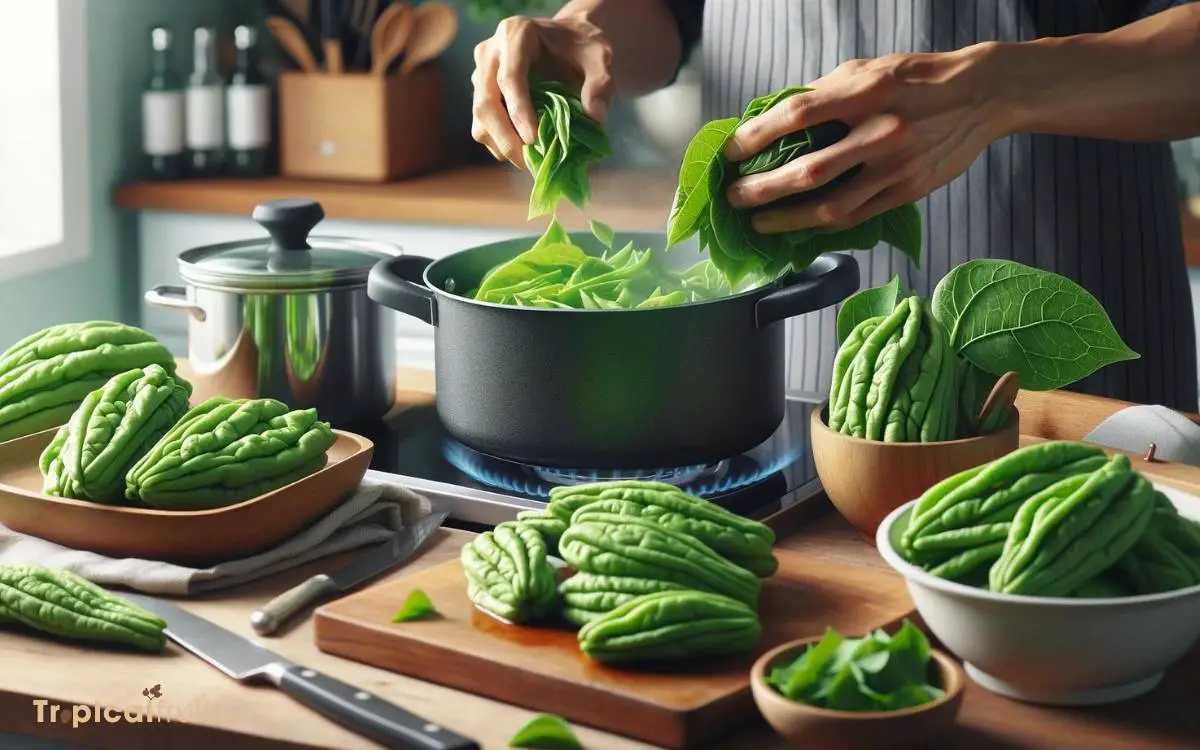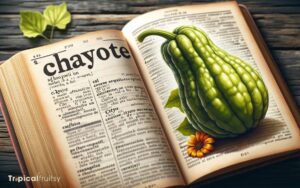How to Cook Chayote Leaves? 5 Easy Steps!
To cook chayote leaves, start by thoroughly washing them to remove any dirt. Blanch the leaves in boiling water for 1-2 minutes, then quickly transfer them to ice water to stop the cooking process.
Drain the leaves and chop them if desired. In a pan, heat some oil and sauté garlic until fragrant, then add the chayote leaves.
Cook until they’re wilted and tender. Season with salt, pepper, and other spices of your choice. Serve as a side dish or incorporate into stews and soups.
Chayote leaves, often used in Filipino and other Asian cuisines, are a nutritious green vegetable with a mild flavor. They can be prepared similarly to spinach or other leafy greens.
Here’s a brief guide to cooking chayote leaves:
For example, in a Filipino dish, you might add coconut milk and chili peppers to create a rich and spicy side.
Chayote leaves, with their nutritive benefits, can be transformed into a delightful dish by simply sautéing with garlic and spices, offering a taste of tropical cuisine.

Key Takeaway
Step 1: Selecting Fresh Chayote Leaves
We’ll need to choose several vibrant, green chayote leaves, ensuring they’re free from blemishes or signs of wilting for our recipe. It’s crucial that the leaves exhibit a lively green hue and a firm texture, indicating optimal freshness and nutritional value.
When we examine the leaves, let’s look for signs of crispness; they should snap gently when bent, a sure sign of their readiness for cooking.
Avoid leaves with any discoloration or spots, as this could suggest the onset of decay or disease. Ideally, we’d select leaves that are uniform in size to ensure even cooking times.
Step 2: Preparing the Leaves for Cooking
Having selected the freshest chayote leaves, we’re now ready to wash and trim them before cooking. Proper preparation is crucial to ensure they’re clean and palatable.
Here’s how we do it:
- Rinse Thoroughly: Place the leaves in a large bowl of cold water. Swirl them gently to remove any dirt or debris. Lift them out and repeat until the water runs clear.
- Check for Pests: Inspect each leaf for insects or eggs. If you find any, remove them carefully.
- Trim the Stems: Using a sharp knife, cut off the tough stems as these parts aren’t usually eaten.
- Pat Dry: Lay the leaves out on a clean kitchen towel and gently pat them dry.
This process ensures our chayote leaves are ready for a delicious and healthy meal.
Step 3: Cooking Methods Explored
After preparing the chayote leaves, we’re ready to dive into various cooking methods that will bring out their delicate flavor and texture.
Sautéing is a quick and versatile technique; a few minutes in hot oil with garlic and we’ve unlocked their earthy notes.
Steaming is another excellent option, preserving nutrients and the subtle taste, making them a perfect canvas for dressings or sauces.
For those who enjoy a bit of crunch, stir-frying with a mix of vegetables can enhance the leaves’ texture.
Lastly, incorporating them into soups adds a layer of complexity and provides a gentle softness to the broth.
Step 4: Flavor Pairings and Ideas
In our culinary exploration, we’ve discovered that several flavors pair exceptionally well with chayote leaves. These vibrant greens have a subtle taste, which makes them versatile for various culinary creations.
To enhance your dishes, consider the following combinations:
- Garlic and olive oil: A classic duo that brings out the earthy notes of the leaves.
- Coconut milk: For a tropical twist, it adds creaminess and a hint of sweetness.
- Citrus juices: Lemon or lime brightens the flavor profile, adding a refreshing zing.
- Chili flakes: A sprinkle introduces a gentle heat that complements the mildness of the chayote leaves.
These pairings elevate the leaves, creating dishes that resonate with depth and harmony. Use these suggestions to craft a meal that’ll impress with its nuanced flavors.
Step 5: Storing and Preserving Leftovers
Once we’ve savored our chayote leaf dishes, it’s important to store any leftovers properly to maintain their freshness. We should cool the cooked leaves to room temperature quickly to prevent bacterial growth.
Then, place them in airtight containers; these can be either glass or BPA-free plastic. Refrigerating the leaves will keep them fresh for a couple of days.
If we’re looking to preserve them longer, freezing is an excellent option. To do this, spread the leaves on a baking sheet and freeze until solid before transferring to freezer bags, which helps prevent clumping.
Label the bags with the date to ensure we use them within three months for the best quality.
Always reheat leftovers to a piping hot temperature before serving to ensure safety and enjoyability.
Conclusion
We’ve explored the versatility of chayote leaves in the kitchen, from selection to savory dishes.
Did you know, in some cultures, chayote isn’t just a food but a medicinal plant too? It’s fascinating that nearly 80% of the population in these regions use it for both purposes.
Now that we’ve mastered the art of cooking these nutritious greens, let’s incorporate them into our meals more often, ensuring we don’t waste a single leaf.
Remember, storing leftovers properly keeps the goodness going!






